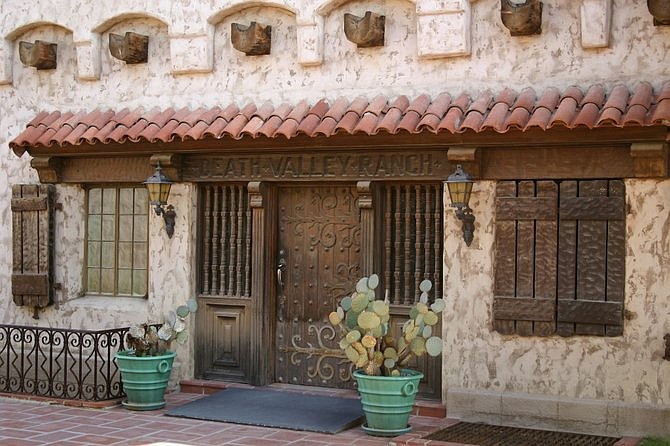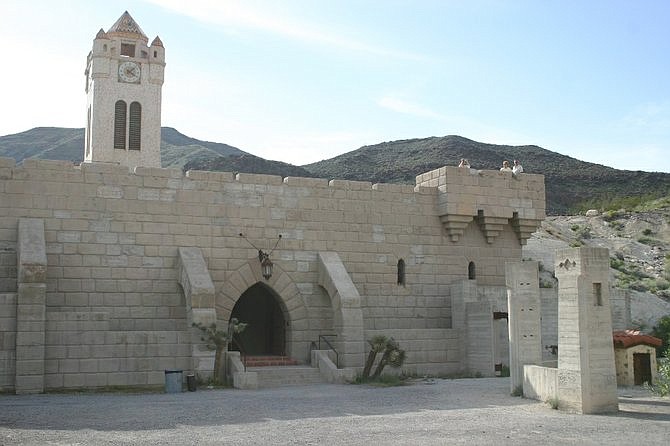 Facebook
Facebook
 X
X
 Instagram
Instagram
 TikTok
TikTok
 Youtube
Youtube

When castles and California are mentioned in conversation, Hearst Castle, which dominates a stretch of Central Coast skyline, usually comes to mind. You might be surprised to learn that a less opulent but even more fascinating castle sits in the magnificent desolation of Death Valley: Scotty’s Castle.
How it came to be is a story worth telling.

Walter Edward Perry Scott was born in Kentucky in 1872 and left home for the road at age 11. By the time he turned 16 he was part of Buffalo Bill Cody’s Wild West Show, touring the United States and Europe. He left the show at 28, got married, had a son, and started what became a failed gold mining operation in Colorado.
Along the way he honed his gift of gab until he was known as a fine storyteller, and he used his talent to launch what would become a lifelong career as a conman. He left his wife and young child and convinced several wealthy investors to give him money for fictitious gold mines he claimed to own.
By 1906 he was infamous enough to star in a play about his life in Seattle, but the run was cut short when he stood trial for defrauding investors. At this time his main cash cow was a Chicago railroad tycoon named Albert Johnson who, enamored by Scott’s prowess as a wordsmith, refused to believe that he was a fraud and stood by him. Scott had leased a played-out mine as a front for his con game and begun stealing high grade ore from operating mines in the area to fleece investors. By 1912 his life caught up with him, and he was sent to prison.
1915 found Scott living alone in Twentynine Palms, at the time a barren desert oasis in the low desert. Johnson came to visit him – and was so fond of his tall tales that he not only forgave him but offered him a home on the vacation ranch he owned in Death Valley.

In 1922 Johnson began construction on an ornate structure in Death Valley's Grapevine Canyon, a hodgepodge of various European castles complete with towers, parapets, elevated walkways and a moat with underwater viewing ports to watch visitors swimming from below.
This grand enterprise sits at 3,000 feet in elevation, halfway between the scorching summer sun of the valley floor and a towering wall of mountains behind. Its construction was overseen by Los Angeles architect, Charles MacNellidge, who hired close to 100 local Shoshone Timbisha Indians as laborers. Materials had to be trucked 18 miles from the nearest railway station.

MacNellidge employed Spanish colonial style to blend with the serenity of the remote desert. While the castle appears to be made of adobe, it’s actually stucco over a wooden frame. Three-foot-thick walls and deep-set windows keep out the summer heat, while a layer of insulation between the walls helped trap the warmth of five winter fireplaces. The interior boasts dark wood-beamed ceilings and sconcing decorated with delicate hand-painted European tiles. Stained glass lamps, imported carpets and exotic collectables fill every room. Stepping inside from the desert gives you an overpowering sense of wealth.
Soon a permanent guest at the castle – still under construction – Scott told audiences about his fear of robbers coming for his gold. To counter such an event, he ordered a curious-looking brass plate installed in his room, through which he could fire his shotgun at intruders outside.
Thanks to his golden tongue, Scott became a permanent fixture at the Johnson’s dinner parties for their East Coast aristocratic friends. Most of them found him charming even if the larger-than-life accounts of his adventures pushed the limits of imagination.
He loved to talk about “his” castle, and even though its official name was the “Death Valley Ranch” it became known far and wide as Scotty’s Castle.
In 1933, construction of the castle was permanently halted due to a labor dispute between Johnson and the federal government. Most of the work was still in the planning stages. It was donated to a local religious organization with the proviso that Scott be allowed to live there until his death, which came in 1954 at age 82.
During the intervening years, Scott remained a local celebrity, entertaining guests with his tales of gold mines and vast wealth. He became known far and wide as “Death Valley Scotty” while legends were spun about the gold that built his castle. He was buried on a hill overlooking the castle, and today that spot is marked with a simple wrought iron cross.
By the time of his death, Scott’s fame was so widespread that his long-abandoned wife attempted to sue his non-existent estate for support, refusing to believe he never really had any money. When that failed she went after Johnson, claiming he had defrauded her prodigal husband out of his fortune. Although this was a fabrication, Johnson felt such loyalty to Scott that even in his reduced financial state he gave a monthly stipend to Scott’s widow until her death.
Today, the castle is part of the Death Valley National Park and is open to the public for tours. Its opulence, both inside and out, sits in stark contrast to the desolate beauty of its surroundings.
Scotty’s Castle is a part of Southern California folklore, and its legend only continues to grow with time. It will remain an unfinished vision.


When castles and California are mentioned in conversation, Hearst Castle, which dominates a stretch of Central Coast skyline, usually comes to mind. You might be surprised to learn that a less opulent but even more fascinating castle sits in the magnificent desolation of Death Valley: Scotty’s Castle.
How it came to be is a story worth telling.

Walter Edward Perry Scott was born in Kentucky in 1872 and left home for the road at age 11. By the time he turned 16 he was part of Buffalo Bill Cody’s Wild West Show, touring the United States and Europe. He left the show at 28, got married, had a son, and started what became a failed gold mining operation in Colorado.
Along the way he honed his gift of gab until he was known as a fine storyteller, and he used his talent to launch what would become a lifelong career as a conman. He left his wife and young child and convinced several wealthy investors to give him money for fictitious gold mines he claimed to own.
By 1906 he was infamous enough to star in a play about his life in Seattle, but the run was cut short when he stood trial for defrauding investors. At this time his main cash cow was a Chicago railroad tycoon named Albert Johnson who, enamored by Scott’s prowess as a wordsmith, refused to believe that he was a fraud and stood by him. Scott had leased a played-out mine as a front for his con game and begun stealing high grade ore from operating mines in the area to fleece investors. By 1912 his life caught up with him, and he was sent to prison.
1915 found Scott living alone in Twentynine Palms, at the time a barren desert oasis in the low desert. Johnson came to visit him – and was so fond of his tall tales that he not only forgave him but offered him a home on the vacation ranch he owned in Death Valley.

In 1922 Johnson began construction on an ornate structure in Death Valley's Grapevine Canyon, a hodgepodge of various European castles complete with towers, parapets, elevated walkways and a moat with underwater viewing ports to watch visitors swimming from below.
This grand enterprise sits at 3,000 feet in elevation, halfway between the scorching summer sun of the valley floor and a towering wall of mountains behind. Its construction was overseen by Los Angeles architect, Charles MacNellidge, who hired close to 100 local Shoshone Timbisha Indians as laborers. Materials had to be trucked 18 miles from the nearest railway station.

MacNellidge employed Spanish colonial style to blend with the serenity of the remote desert. While the castle appears to be made of adobe, it’s actually stucco over a wooden frame. Three-foot-thick walls and deep-set windows keep out the summer heat, while a layer of insulation between the walls helped trap the warmth of five winter fireplaces. The interior boasts dark wood-beamed ceilings and sconcing decorated with delicate hand-painted European tiles. Stained glass lamps, imported carpets and exotic collectables fill every room. Stepping inside from the desert gives you an overpowering sense of wealth.
Soon a permanent guest at the castle – still under construction – Scott told audiences about his fear of robbers coming for his gold. To counter such an event, he ordered a curious-looking brass plate installed in his room, through which he could fire his shotgun at intruders outside.
Thanks to his golden tongue, Scott became a permanent fixture at the Johnson’s dinner parties for their East Coast aristocratic friends. Most of them found him charming even if the larger-than-life accounts of his adventures pushed the limits of imagination.
He loved to talk about “his” castle, and even though its official name was the “Death Valley Ranch” it became known far and wide as Scotty’s Castle.
In 1933, construction of the castle was permanently halted due to a labor dispute between Johnson and the federal government. Most of the work was still in the planning stages. It was donated to a local religious organization with the proviso that Scott be allowed to live there until his death, which came in 1954 at age 82.
During the intervening years, Scott remained a local celebrity, entertaining guests with his tales of gold mines and vast wealth. He became known far and wide as “Death Valley Scotty” while legends were spun about the gold that built his castle. He was buried on a hill overlooking the castle, and today that spot is marked with a simple wrought iron cross.
By the time of his death, Scott’s fame was so widespread that his long-abandoned wife attempted to sue his non-existent estate for support, refusing to believe he never really had any money. When that failed she went after Johnson, claiming he had defrauded her prodigal husband out of his fortune. Although this was a fabrication, Johnson felt such loyalty to Scott that even in his reduced financial state he gave a monthly stipend to Scott’s widow until her death.
Today, the castle is part of the Death Valley National Park and is open to the public for tours. Its opulence, both inside and out, sits in stark contrast to the desolate beauty of its surroundings.
Scotty’s Castle is a part of Southern California folklore, and its legend only continues to grow with time. It will remain an unfinished vision.
Comments